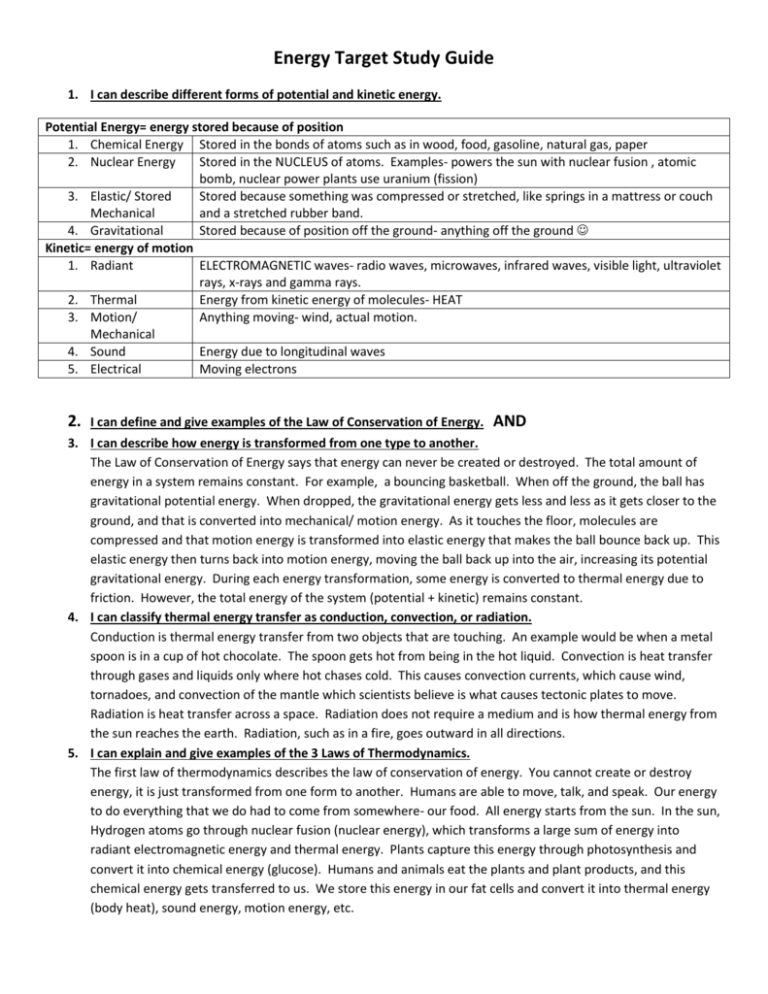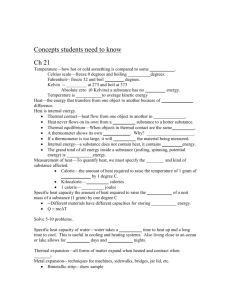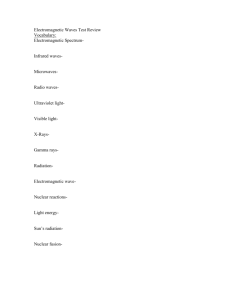Energy Target Study Guide
advertisement

Energy Target Study Guide 1. I can describe different forms of potential and kinetic energy. Potential Energy= energy stored because of position 1. Chemical Energy Stored in the bonds of atoms such as in wood, food, gasoline, natural gas, paper 2. Nuclear Energy Stored in the NUCLEUS of atoms. Examples- powers the sun with nuclear fusion , atomic bomb, nuclear power plants use uranium (fission) 3. Elastic/ Stored Stored because something was compressed or stretched, like springs in a mattress or couch Mechanical and a stretched rubber band. 4. Gravitational Stored because of position off the ground- anything off the ground Kinetic= energy of motion 1. Radiant ELECTROMAGNETIC waves- radio waves, microwaves, infrared waves, visible light, ultraviolet rays, x-rays and gamma rays. 2. Thermal Energy from kinetic energy of molecules- HEAT 3. Motion/ Anything moving- wind, actual motion. Mechanical 4. Sound Energy due to longitudinal waves 5. Electrical Moving electrons 2. I can define and give examples of the Law of Conservation of Energy. AND 3. I can describe how energy is transformed from one type to another. The Law of Conservation of Energy says that energy can never be created or destroyed. The total amount of energy in a system remains constant. For example, a bouncing basketball. When off the ground, the ball has gravitational potential energy. When dropped, the gravitational energy gets less and less as it gets closer to the ground, and that is converted into mechanical/ motion energy. As it touches the floor, molecules are compressed and that motion energy is transformed into elastic energy that makes the ball bounce back up. This elastic energy then turns back into motion energy, moving the ball back up into the air, increasing its potential gravitational energy. During each energy transformation, some energy is converted to thermal energy due to friction. However, the total energy of the system (potential + kinetic) remains constant. 4. I can classify thermal energy transfer as conduction, convection, or radiation. Conduction is thermal energy transfer from two objects that are touching. An example would be when a metal spoon is in a cup of hot chocolate. The spoon gets hot from being in the hot liquid. Convection is heat transfer through gases and liquids only where hot chases cold. This causes convection currents, which cause wind, tornadoes, and convection of the mantle which scientists believe is what causes tectonic plates to move. Radiation is heat transfer across a space. Radiation does not require a medium and is how thermal energy from the sun reaches the earth. Radiation, such as in a fire, goes outward in all directions. 5. I can explain and give examples of the 3 Laws of Thermodynamics. The first law of thermodynamics describes the law of conservation of energy. You cannot create or destroy energy, it is just transformed from one form to another. Humans are able to move, talk, and speak. Our energy to do everything that we do had to come from somewhere- our food. All energy starts from the sun. In the sun, Hydrogen atoms go through nuclear fusion (nuclear energy), which transforms a large sum of energy into radiant electromagnetic energy and thermal energy. Plants capture this energy through photosynthesis and convert it into chemical energy (glucose). Humans and animals eat the plants and plant products, and this chemical energy gets transferred to us. We store this energy in our fat cells and convert it into thermal energy (body heat), sound energy, motion energy, etc. The second law of thermodynamics is described as entropy (disorder). In every energy transformation, some energy is converted into thermal energy. Often times this heat is unusable and will not be able to be transformed into another form of energy. So, although the total amount of energy in the universe will always remain constant, the usefulness of this energy will constantly decrease, so the world will increase in entropy (disorder) more and more as time goes by. The third law of thermodynamics describes the theory that all molecules have kinetic (thermal) energy until they reach absolute zero (-273°C). At absolute zero, all particle motion would stop. We have never been to absolute zero, but scientists have come very close in a laboratory. Several years ago, scientists at the University of Colorado at Boulder froze particles of Rubidium to a fraction of a degree above absolute zero and the matter changed state to Bose-Einstein Condensate that had properties different than a solid. 6. I can label the parts of a wave and predict wave behavior and energy transfer. Waves are a disturbance that carry energy (not matter). Some do disturb matter in that they vibrate particles. Waves have certain behaviors that predict the way they will act/ react. Absorption- Waves decrease in amplitude and energy when they are absorbed by soft materials. For example, yelling into a pillow. Reflection- Waves can bounce off hard surfaces and reflect back in the opposite direction. For example, light and your reflection in a mirror or sound and an echo. Refraction- Waves can be bent when passing from one medium to another. For example- a pencil appears “broken” when viewed at eye level in a glass of water with one end of the pencil sticking out. A prism bends light and separates white light into different colors. Diffraction- Some waves can go around corners and through barriers, such as sound waves. As for water waves, they hang onto corners and changes the shape of the mechanical wave. Interference- constructive interference is when two waves that are in the same phase meet and the amplitude of the wave (and energy of the wave) increase. Destructive interference is when two waves that are out of phase meet and cancel part of their amplitude out, so their energy is decreased. 7. I can describe an electromagnetic wave and compare them to longitudinal and transverse waves. An electromagnetic (EM) wave consists of an electric field and a magnetic field perpendicular to each other, but acting as one. This makes up RADIANT energy and includes all the types of energy on the Electromagnetic Spectrum. EM waves can travel through empty space, while all other waves require a medium. They do not disturb matter.









